The output file doesn’t contain any dummy or sample data in it. But it is good for various testing purposes. Apart from that, you can also set file type (say TXT, PDF, etc.) or file extension to create your test file.
How to create large size dummy files in Windows 11/10
For all those users, who need to download large sample files for testing purposes from time to time, this native feature of Windows 11/10 is surely very useful. Instead of searching the internet to get sample files every time, you can create them by yourself without using any third-party tool. First of all, open or launch Command Prompt, and then you need to enter a command with the following items: Let’s say you want to create a 100 MB text file on the desktop, with name sample, then the command would be: Replace username with the actual name of your PC in the command. Execute the command and a dummy file of 100 MB size will be created quickly. Similarly, if you want to create a 1 GB test file, then run the above command by entering file size as 1073741824. You can use some unit converter to convert MB to bytes or GB to bytes to get the exact number for your test file. Hope this post is helpful.
How do I view large files?
To view large files, you can use third-party tools including Notepad++, Sumatra PDF, nomacs, and VLC. These applications allow you to view files of different file types that are large in size. For example, to view high-definition and 4K quality videos that are large in size, you can use VLC. Similarly, large text files can be viewed in Notepad++.
How do I make a large test file?
These tools can help you make a large test file or fake file having the size in MBs, GBs, etc., quickly and easily. If you want some large test files, these fake file generator tools might be helpful. You can also set file type (say PDF, TXT, etc.) using most of these tools.

